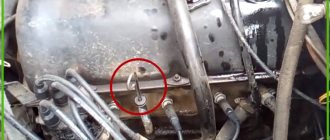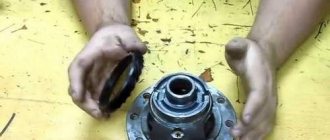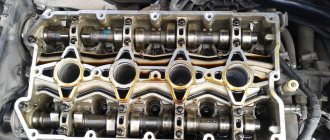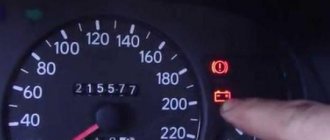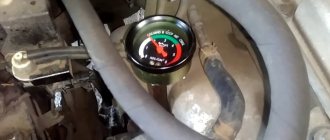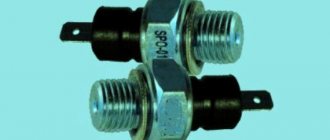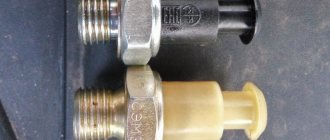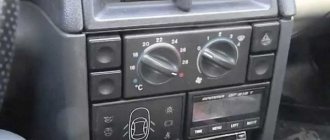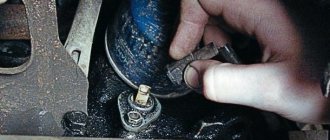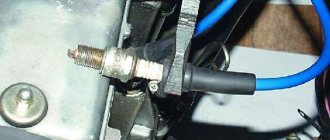The lubrication system of an internal combustion engine performs four main functions: it reduces the friction force between the mating elements of the power unit, cools them, protects them from corrosion and cleans them of fuel combustion products and wear. To perform these functions, a certain oil pressure is maintained in the engine. Insufficient or excessive pressure will lead to rapid wear and destruction of rubbing parts. Pressure control is carried out using a special sensor and indicator (control lamp on the dashboard). We will tell you when this indicator lights up and what actions the car owner should take.
Operating principle of the lubrication system
Lubrication of moving engine components occurs according to the following principle: oil gradually flows into a recess located in the sump, after which it is sucked in by an oil pump, passed through an oil filter and again supplied to the loaded components.
The latter include:
- crankshaft plain bearings;
- cylinder walls;
- cylinder head;
- all gear mechanisms.
A sensor that monitors oil pressure is installed at the top of the cylinder head, at the point where the lubricant passages end. Thanks to this, the sensor monitors the oil at all stages of its movement, starting from the oil pump and ending with the camshaft.
The design of the ODM itself (oil pressure sensor) includes only three main parts - its housing, electronic contacts for signal transmission and a sensitive membrane. Depending on the oil pressure, it either closes the electrical circuit or opens it. If the pressure is less than the permissible threshold (0.65 Bar), then the sensor is triggered and the oil light for VAZ 2114 lights up on the panel.
As soon as the light comes on, you should stop driving as quickly as possible and search for possible faults. Operating a vehicle with an inoperative oil supply system can lead to rapid wear of moving parts and even engine failure.
Why troubleshooting should be done as soon as possible
If while driving the oil pressure in the VAZ 2114 engine suddenly drops and the light comes on, then you cannot continue the trip. You should stop and try to find out in the field the possible cause of the breakdown.
Continuing to drive with a faulty oil system can lead to a number of negative consequences for the car, including:
- Running the moving parts of the engine dry, which will ultimately lead to severe wear and overheating. The longer the engine runs without oil, the greater the damage to it and adjacent components will be (ultimately, all this can lead to crankshaft jamming and engine failure).
- Camshaft wear.
- Clogging of the pressure relief valve with metal particles formed during dry operation and damage to the oil pump. In addition, such particles can clog the lubrication channels in the engine, which can only be cleaned during a major overhaul.
Crankshaft VAZ 2114
Reasons why the indicator light may come on
The indicator light can light up both while driving and at idle speed. Before making assumptions about the causes of possible malfunctions, you should observe the behavior of the light bulb. If it lights up periodically and only while driving, the problem should be looked for in the sensor wiring. If the lamp lights up when the engine is idling and does not go out, this may be due to:
- faulty pressure sensor;
- low oil level;
- too liquid (not corresponding to the class or expired) oil;
- oil pump malfunction;
- oil filter wear;
- contamination of the oil receiver mesh;
- wear of the crankshaft liners.
Let's consider each of these situations in more detail.
Sensor Wiring
Flashing of the indicator light while driving may be due to damaged insulation of the sensor wire. The wire, under the influence of vibration, shorts to the ground of the car, which causes the sensor to operate. This problem can be eliminated by thoroughly inspecting the wiring and replacing the damaged section.
One of the reasons for the light to come on may be damage to the pressure sensor wiring.
Sensor
In VAZ 2114/15 cars, the oil pressure sensor often fails. Most often, it is this that causes the indicator lamp to constantly burn. It is impossible to check its serviceability yourself. Usually a new sensor is purchased and installed.
A faulty VAZ 2114/15 pressure sensor often causes the oil pressure lamp to light up
Lubricant level and quality
If the indicator light is constantly on, you should check the oil level in the oil pan. This is done with a special probe on a cold engine. If the level is below the minimum allowable, you should add the substances and observe the behavior of the light bulb. If it went out, the problem was precisely the lack of lubrication.
Another reason for the indicator light to come on may be that the oil consistency is too thin. The fact is that the viscosity of the oil decreases with each kilometer traveled. If the car has traveled more than 10 thousand km without changing the oil, the oil pump, designed for a certain lubricant viscosity, will not be able to create the necessary pressure. In such cases, the light comes on only when the engine warms up to operating temperature. This is due to a decrease in oil viscosity due to heat.
Oil viscosity decreases over time, causing system pressure to drop.
This problem can be solved by simply changing the oil. If the indicator continues to light, troubleshooting should be continued.
Pressure measurement
To measure the oil pressure in the system, a liquid pressure gauge is used. The nozzle of its hose is screwed in instead of the pressure sensor. First, measure the pressure at idle speed of a warm engine. A pressure of 1.5 to 2 bar is considered normal. Then the measurements are repeated at high speeds (5000–5500 rpm). In this case it must be at least 4.5 bar.
If the pressure gauge shows values below those specified, you should check the oil pump, since it is the one that creates pressure in the system. It is not recommended to continue operating the vehicle in this case.
The main malfunctions of the oil pump are wear of its elements and “sticking” of the pressure relief valve in the open position. In this case, the easiest way is to replace the pump as a set. You can do this either yourself or at a car service center.
Elimination methods
Now you can go directly to the elimination methods. First, you need to figure out what tools you may need to complete the process: a 10mm wrench, a multimeter, a set of screwdrivers. Now that everything is collected, you can move directly to solving problems.
Low oil level on dipstick
The dipstick is used to measure the oil level in the engine.
Also, the cause of oil loss in the engine may be a faulty gasket or a breakdown in the engine crankcase. In order to eliminate oil loss, it was necessary to eliminate the malfunctions that caused the effect, and then add oil to the required level.
To measure the oil level, there is a special tool called an oil dipstick. It is located on the front of the engine. The oil level in the engine should be midway between the minimum and maximum indicators. When the indicator drops below the MIN mark, the oil level indicator lights up on the dashboard.
Sensor malfunction
A sensor malfunction can also cause an oil level indicator to appear on the dashboard. To eliminate the malfunction, you need to check the sensor, and if it is faulty, replace the part.
Old and new oil level sensor The replacement process is quite simple and not complicated. Let's consider the issue in more detail. To complete the operation, you will need a key for 10. So, let’s proceed directly to the sequence of actions aimed at replacing the sensor:
- The car must be installed so that there is access from below. A viewing hole, a lift or an overpass is suitable for this.
- Disconnect the negative terminal on the battery.
Remove the negative terminal from the battery.
If there is, it is necessary to remove the lower engine protection.
Remove the engine crankcase protection.
We dismantle the pallet. You must first drain the oil from the engine through the drain plug.
We dismantle the pallet.
Disconnect the wire block from the sensor. We clean the engine oil level sensor from dirt. Disconnect the block from the wires. Using a wrench or a 10mm socket, unscrew the oil level sensor. We install a new sensor and carry out the necessary assembly.
Contact circuit problem
Diagnostics of the fuel level sensor chip More than once, the cause may be a break in the wires or contact group that goes from the sensor to the electronic control unit. Based on the electrical diagram of the car, we find the corresponding wire that powers the meter. Next, we find exactly the same one in the ECU and call it.
Short circuit inside the instrument panel
More than once, a short circuit inside the dashboard board can be the cause of a light on the dashboard. This may be caused by corrosion damage or a short circuit inside the instrument panel. Thus, the solution to the problem may be to repair the board or replace the instrument cluster.
Checking the contacts of the dashboard board It is quite easy to determine the malfunction: you just have to disassemble the device and look at the contact connections. Also, to be completely sure, you can ring the contacts on the board and directly on the indicator lamp itself, using a tester.
Malfunctions in the VAZ-2114 ECU
The last possible option to look for a fault is the electronic control unit. Errors may occur here that will not only cause the oil level light to light up, but also cause other indicators to malfunction, such as the speedometer, turn signal, and others.
The method of troubleshooting is to connect a laptop or tablet to the “brains” of the car via an OBD cable and a standard test. If errors related to the oil level are detected in the ECU, they must be reset. The procedure for resetting all errors should be done for all indicators that have accumulated in the “brains”. After this, the problem should disappear; if not, then the fault must be looked for elsewhere.
Why does the alarm sound?
The reasons why the VAZ 2114 oil pressure is on may be:
- Damage to the oil pressure sensor.
- A break in the wires connecting the pressure sensor to the electronic unit.
- Low oil level in the system.
- Oil pump failure.
- Oil filter clogged.
Of all the above reasons, the last two pose the greatest danger to the moving parts of the vehicle. If the DDM itself breaks down, the cause can be eliminated literally in a matter of minutes. In addition to the above malfunctions, in which the signal in the form of an oil can on the dashboard lights up constantly, there are situations when it lights up periodically, either lighting up or going out.
The reasons for this behavior of the indicator may be:
- clogged filter mesh on the oil intake of the pump, which leads to improper operation of the latter;
- oil filter clogged;
- low oil viscosity due to its wear (it was not replaced for a long time);
- low oil viscosity due to gasoline entering the crankcase;
- short circuit of the wires connecting the DDM with the indicator on the dashboard;
- wear of crankshaft bearings.
Eliminating these causes will help completely get rid of the blinking pressure sensor on the panel.
The oil can indicator light came on while driving.
In cases where the oil pressure light suddenly comes on while the car is moving, it is advisable to stop immediately. Probably the following failure or breakdown occurred:
- the oil level in the engine unit is below the Min mark;
- the oil filter could be clogged - this leads to the fact that the pressure invariably decreases;
- it's time to change the oil - in cases where the car owner does not replace the substance in the engine for a long time, it loses its working properties.
Useful tips
To prevent problems associated with a drop in oil pressure, the following recommendations should be followed:
- Fill the engine with oil recommended by the car manufacturer, paying attention to the viscosity grade.
- Change the oil and oil filter in a timely manner.
- Do not use non-original spare parts for repairs.
- At least once a quarter, carry out diagnostics of the lubrication system with mandatory pressure measurement.
- If the pressure indicator light comes on, do not operate the vehicle until a complete diagnosis has been carried out.
Ignoring the oil pressure indicator signals can have serious consequences for the car engine. Any malfunction of the lubrication system can lead to a major overhaul of the power unit. Try to keep it in working condition and pay attention to all signals given by the indicator light.
Higher technical education
Home →
Maintenance and Repair →
Engine →
This is interesting: Types of car engines - what do our cars run on nowadays?
Replacement
The oil pressure light blinks at idle speed on a VAZ 2110
Replacing the DUM is not some difficult or complicated task. Any novice driver is quite capable of carrying out the replacement, and to make this work easier, we have prepared instructions. So let's get started:
- First, we place the car on an overpass or inspection hole.
- Turn off the ignition and remove the wire from the negative terminal of the battery.
- We dismantle the engine protection.
- Remove the wire tip from the DUM block (it is located near the oil filter).
- Using a rag, clean the upper part of the measuring device from dust and dirt.
- Take a 10mm socket wrench and unscrew the fastener.
- Gently rocking from side to side, we remove the part from its seat, trying not to damage the float.
- We take a new DUM and carry out the work in reverse order.
The structure of alerting the driver about the operation of the lubrication system also includes an emergency oil pressure sensor.
It also sometimes breaks down and requires replacement. It consists of a housing in which the measuring membrane is located, as well as a transmission mechanism. This membrane can bend and take one or another position. At the same time, it closes or opens the contacts. The easiest way to check the functionality of this device is to replace it with a spare one. If there is no spare, then check by connecting a pressure gauge. It is installed in place of the sensor and the engine is started. At idle, its readings should be at least 0.65 kg/cm2. If this is the case, then the pressure in the engine is normal, and the removed device is out of order and must be replaced.
Sometimes this trouble, when the red light with an oil can blinks, can happen on the road when there are no instruments at hand. In this case, you can use the so-called traditional method of checking DADM. To do this, you need to remove it and crank the starter (without starting the engine!). Oil should squirt out of the mounting hole. If this happens, then there is pressure in the engine and, at least, you can get to the garage, where in a calm atmosphere you can find out the cause of what happened.
It is very easy to replace this device. You need to remove the decorative trim from the car engine. Find the upper part of the measuring device and remove the boot from it, under which there is a power wire. Let's take it off too. After this, we unscrew the DADM from the engine block and install a new one in its place.
Make sure there is a sealing washer under the head! We connect the wire, mount the decorative trim, start the engine and check the operation
Oil level sensor
Electric -2114 allows you to control the amount of lubricating fluid in real time during vehicle operation. The signal from it is sent to the corresponding dashboard indicator, notifying the driver about the lack of oil level in the engine sump. Insufficient oil level in the car crankcase leads to engine failure and, as a consequence, to expensive and time-consuming repairs.
Therefore, it is necessary to ensure that there is always a sufficient amount of suitable engine oil in the engine. The volume is approximately 4 liters. When replacing it, the volume of newly filled engine oil is not less than the volume of drained fluid. Reaching the required level is determined using a measuring probe.
Operating principle of DUM
The oil level is based on the use of the properties of a reed switch (a reed switch is a sealed magnetically controlled contact) with make-break contacts. When the sensor is immersed in engine oil, its contacts are open and the indicator is . If the level is insufficient (there is no oil between the contacts of the reed switch), the contacts close, thereby turning on the electrical circuit of the control light on the car’s dashboard.
Helpful advice. While trusting the electrical readings, it is still recommended to check the engine oil level daily using a dipstick.
If the indicator of its insufficiency lights up, it is necessary to verify the reliability of the DUM readings. A measuring probe is used for this.
How to use the test probe
Checking the oil level using a dipstick is carried out as follows (the car must be horizontal):
- remove the dipstick from the tube located under the hood in the front part of the engine compartment, wipe it and find the marked max and min marks;
- install the probe back into the tube;
- After 2-3 minutes, we take out the dipstick again and see where the upper edge of the oil mark is located on it. If the mark is between the min/max marks, then the amount of lubricant in the engine is normal, but the performance of the sensor is in doubt and must be checked.
Why does the DUM indicator light up?
If during a trip the oil level indicator suddenly lights up on the dashboard, you should immediately stop and find out the cause of this phenomenon. Of course, you shouldn’t panic because of this, as the reasons can be different:
- There is not enough fluid in the car crankcase - you need to add oil to the oil filler neck to the required level. The oil to be added must be of the same type as that previously added. Otherwise the engine will fail.
- The level sensor is faulty.
Attention: DUM cannot be repaired. If it breaks, it must be replaced with a new one.
The causes of failure of the DUM are classified as follows:
- Oxidation of contacts;
- Short circuit or break in the power supply circuits of the sensor and/or liquid level indicator;
- Reed switch burnt out.
Lack of oil in the crankcase
The first reason that suggests itself is a low level in the engine crankcase. Because you haven't watched it for a long time. When was the last time you checked the level in the engine?
Every second driver will have a low level of lubricant, top it up and everything goes away. However, I constantly monitor the lubricant, and the level is normal, but the lamp comes on. What to do? Of course, look for the problem.
If the pressure lamp flashes when driving downhill, uphill or on turns, then simply add a little lubricant to the engine. It splashes and in such modes the pump cannot reach it. On a flat surface the level will be within acceptable standards.
I do not consider grease waste and leakage, since this does not apply to our case. As you remember, I explain the reasons for the lamp burning when everything seems to be enough.
oil pressure warning light
- Thank you
- I do not like
Dimbasik 04 Dec 2009 Hello everyone! Tell me what the trick might be?
I turn on the ignition - 3 lamps light up as expected - check engine, battery and oil pressure. I start, drive, stop, turn off, turn on the ignition again - check-in, battery are on, oil pressure light is off. I noticed that it burns mainly when the engine is cold. Poor contact in the instrument panel or what is it? Tell me?
- Thank you
- I do not like
alekssmol 04 Dec 2009 Hello everyone! Tell me what the trick might be?
I turn on the ignition - 3 lamps light up as expected - check engine, battery and oil pressure. I start, drive, stop, turn off, turn on the ignition again - check-in, battery are on, oil pressure light is off. I noticed that it burns mainly when the engine is cold. Poor contact in the instrument panel or what is it? Tell me?
Have you checked the oil level? and of course the contact on the sensor itself. try tapping it lightly
- Thank you
- I do not like
kirill.evs 04 Dec 2009
- Thank you
- I do not like
Dimbasik 04 Dec 2009
- Thank you
- I do not like
anry Dec 04, 2009
- Thank you
- I do not like
Compass 04 Dec 2009 10 seconds did not light up, which means the CPG is working.
First, try installing a sensor that is known to be good.
- Thank you
- I do not like
Dimbasik 04 Dec 2009
- Thank you
- I do not like
KOCTA 04 Dec 2009 also a thought! I understand you are talking about the oil pressure sensor at the oil filter? need to try.
There was such a malfunction, I replaced the oil pressure sensor, it seemed to disappear, but soon the lamp on the tidy came on again, then it didn’t. I found a burnt corrugation with wires, the pressure sensor wire was touching the exhaust manifold pipe (ground), the wire was insulated, and the corrugation pulled it off with zip ties.
Why is the light on the dashboard on?
If you find that the VAZ 2114 oil pressure lamp is on on the dashboard, you must immediately find out the reason for the indicator’s activity.
Keep an eye on the oil pressure indicator to avoid walking later
If the problem is a malfunction of the DDM itself, this is half the problem, the device costs a penny and is replaced within 5 minutes, but if the VAZ 2114 oil pressure sensor is working, then a burning indicator may indicate more serious problems.
Let's look at the main reasons why the VAZ 2114 oil pressure sensor lights up on the instrument panel:
- Failure of the DDM (closed contacts, failed signal transmission mechanism);
- Damage to the wires connecting the DDM and the “brains” of the fourteenth;
- Insufficient amount of oil in the system;
- Faulty oil pump;
- Clogged filter.
The last two reasons are the most serious. If the PDM itself is faulty, the actual pressure in the system is normal and nothing threatens the engine, while driving with a broken pump or filter is strictly contraindicated, since an engine that is not lubricated during operation quickly fails and its repair is very expensive.
Diagnostic features
Before replacing the old device, it must be removed and checked. The easiest way to check is to plug in a known-good device into the network.
Another way is to screw a pressure gauge in place of the sensor. If the tester shows a pressure of 0.65 kgf/cm2 or more, this indicates that the system has normal pressure and the cause is a faulty device.
If you don’t have a pressure gauge at hand, you can check the sensor in the following way:
- unscrew the regulator;
- crank the starter without starting the engine;
- If oil flows from the socket, then the sensor is faulty and needs to be replaced.
Replacing the sensor
In a Priora car, replacing the oil pressure sensor is not very difficult even for novice car enthusiasts who do not have practical experience in plumbing. It is performed if the causes of the defect are determined, if the oil pressure sensor in the power plant lubrication system is on. The procedure for replacing the oil pressure sensor is as follows:
- Turn off the power plant.
- Remove the plastic motor cover.
- We remove the car wiring block from the product.
- We unscrew the device using a socket wrench and remove it from the technological hole in the body of the cylinder head.
- When installing an updated product, it is necessary to install a metal sealing ring.
- We are installing a new device. This completes the installation.
If the oil pressure sensor lights up even with the updated device, it is necessary to test the pressure value in the vehicle’s lubrication complex. For this purpose, instead of the removed device installed in the cylinder head of the engine unit, we screw in an adapter on which the pressure measuring device is installed.
When monitoring the pressure parameter in the lubrication system of the power plant, you should know that the indicator of this physical quantity on the engine at idle speed should be at least 0.5 bar.
How to check and replace the pressure sensor
If you notice that the VAZ 2114 oil pressure sensor is on, then first of all you should check the serviceability of the oil pressure sensor itself. In order to do this, you will need a special device based on a pressure gauge that allows you to measure oil pressure directly.
To make the measurement itself, you will need to remove the oil pressure sensor from its socket and install the device in its place. After this, you need to start the car and look at the pressure gauge readings. If everything is normal, then the arrow will show pressure in the range from 0.65 to 0.7 kgf/sq.cm.
If the measurement results are lower, then the problem should be looked for either in the oil filter (it should be checked first) or in the oil pump itself. In rare cases, the indicator light can also be caused by absolute wear of the crankshaft bearings, requiring their complete replacement.
If you don’t have a special oil pressure gauge at hand, but you need to check the serviceability of the sensor, then you can resort to the “field” test method. To do this, unscrew the DDM and start the car starter (there is no need to start the engine). If oil begins to fly out of the open hole, then the pressure in the system is completely normal and you can continue driving.
Having discovered that the reason why the oil pressure lamp is on on the VAZ 2114 lies in the pressure sensor itself, the latter should be replaced. It's very easy to do.
To do this, you only need a regular 21 open-end wrench, and the operation itself is performed as follows:
- Open the hood and remove the protective cover from the engine.
- Find the sensor (it is located on the left side of the engine, next to the timing belt) and remove the cap with the connector from it).
- Using a 21 key, unscrew the sensor from its socket.
- Screw in a new sensor instead of the broken one.
- Connect it to the electronic system by putting a cap with contacts on it.
As you can see, the whole procedure is very simple and will only take a few minutes.
Another important point worth mentioning is the frequent failure of pressure sensors, accompanied by oil leakage through them. This is caused by a malfunction of the excess pressure relief system on the oil pump, as a result of which the total pressure in the system increases greatly and oil leaks through the sensor socket. To eliminate this problem, you will have to replace the oil pump with a new one.
We fix problems ourselves
The oil can icon may not light up for various reasons:
- wiring problems;
- malfunction of the sensor itself;
- the indicator light has burned out;
- The fluidity of the oil is temporarily impaired due to low temperatures and prolonged storage.
The first three reasons can be considered a signal to action, since they must be eliminated as soon as possible for safe operation of the machine. The fourth reason has only one way out - start the engine and wait for the oil to spread throughout all components and parts.
The first indicator on the left shows malfunctions in the engine lubrication system
Preparing tools for repair
To troubleshoot the oil pressure light, you may need the following tools and devices:
- screwdriver with a flat thin blade;
- pressure gauge;
- new indicator light;
- wires;
- sensor.
Operating procedure
First of all, car enthusiasts are advised to start by inspecting the sensor and its connector, and only then move on to solving other issues.
If the sensor has a whole body and the connector is connected correctly, then it is recommended to check other elements of the system
To make it easier to find a fault, it is better to adhere to the following operating scheme:
- Check the connector that connects to the oil pressure sensor. As a rule, the sensor is located on the engine cylinder block, usually on the rear side. You can find out the exact location of this element in your car's manual. It is recommended to remove the connector, make sure that it is clean and free of dirt, and then connect it back. If this simple procedure does not help, move on to the second point.
- Measure the oil pressure with a pressure gauge. It should be within the range specified in your vehicle's owner's manual. If this is not the case, change the oil pressure sensor.
- After this, you can remove the wiring from the sensor and connect it to the engine ground. If the oil can in the passenger compartment does not start to burn, then you will have to check the entire wiring or change the indicator light.
- It is easier to replace the light bulb on the indicator - it is quite possible that it has simply burned out, and therefore does not light up at those moments when it is necessary. It is enough to remove the protective strip from the instrument panel, unscrew the old lamp and insert a new one.
- If this does not help, then the last chance to fix the problem is to replace the wires. You can usually visually notice abrasions or breaks. It is recommended to immediately replace the entire wire rather than trying to rewind it with electrical tape.
The oil light is on on a VAZ 2114
Engine oil pressure is one of the most important parameters of its operation, so it is necessary to monitor the condition of the oil pressure gauge.
The indicator light came on, what to do. Let's look at several cases in which the light comes on and, based on each case, draw a conclusion about the possible cause of the malfunction.
The light comes on when the engine is idling and goes out as the engine speed increases. In this case, the possible cause of the malfunction may be:
1. Wear of the crankshaft liners - in this case, the pressure drops due to an increase in the gap between the liner and the engine connecting rod or the liner and the engine block, depending on the type of liner (connecting rod, main). In this case, troubleshooting is possible only after a major overhaul of the engine, with boring the shaft and replacing the liners, or replacing the crankshaft. This is the most common reason for the oil pressure light to come on, but there may be others.
2. Clogging of the oil receiver screen is a fairly common reason; in this case, it is due to a large amount of deposits accumulated in the engine sump, and therefore an insufficient amount of oil flows through the clogged screen into the oil pump. This malfunction is not difficult to fix - just clean the mesh and remove all accumulated dirt from the pan. To prevent clogging of the oil receiver mesh, it is necessary to flush the engine using special flushing oils.
3. Malfunction of the oil pump - in this case, the light may come on due to low oil pressure produced by the oil pump; this reason is quite rare and difficult to diagnose. We can only assume the presence of this malfunction by eliminating other possible causes. This cause can be eliminated by replacing the oil pump.
4. Malfunction of the oil pressure sensor . This malfunction can only be diagnosed by replacing the sensor with a known good one, or by connecting a mechanical pressure sensor. If, after replacing the sensor, the light stops lighting up, then this is the reason.
The light is constantly on, in this case we can assume that since your engine still hasn’t knocked or jammed, it means that the reason is not the oil pressure, otherwise you would have already understood everything yourself. We are looking for the following possible causes of the malfunction:
1. The oil pressure sensor is faulty - the solution is described above in accordance with paragraph 4 2. Short circuit in the wiring. It can be diagnosed by checking with a mechanical pressure sensor, if the mechanical sensor shows sufficient pressure, while replacing the sensor with a new one does not produce results, respectively, there is a short circuit in the light bulb circuit somewhere.
The bottom line is that when the oil pressure light comes on, you must first turn off the engine and take the car to the nearest service station, where experienced specialists will diagnose the cause of the malfunction. Otherwise, there is a chance, when attempting self-diagnosis, to completely ruin the engine.
Share this article with your friends:
Replacing the DUM
The battery charging light is on. Why is the battery charging light on even though it is charged?
In practice, replacing the DUM looks quite simple. Therefore, do not rush to take your car to a service station and pay unreasonably large amounts of money for the services of specialists. You can easily do their work yourself, plus save a lot of money.
Follow the step-by-step instructions so that your old DUM can retire to its well-deserved rest, and the new device can begin to perform its functions.
- Place the car on the inspection pit. An alternative could be an overpass. Someone here already has what.
- Turn off the ignition, disconnect power from the battery. To do this, simply disconnect the negative terminal on the battery.
- Remove the engine protection. If you performed a test and it showed that it was not working, then your protection has already been removed.
- Near the oil filter, find a wire tip that should be removed from the sensor block.
- Using dry, lint-free cloths, clean off any dirt that may have accumulated on the surface of your sensor over time.
- Using a 10 mm socket wrench, remove the fastening element holding the oil level meter.
- Rock the sensor from side to side with your hands, which will allow you to gradually remove the device from the socket. Proceed carefully, otherwise you can easily damage the float.
- Arm yourself with a new sensor and put it in place.
- Assembly is performed strictly in reverse order.
- At the final stage, do not forget to test the new device in action.
